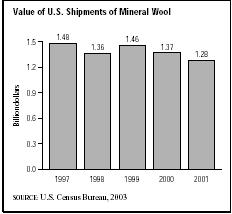SIC 3297
NONCLAY REFRACTORIES
This category includes establishments primarily engaged in manufacturing refractories and crucibles made of materials other than clay. This industry also includes establishments primarily engaged in manufacturing all graphite refractories, whether of carbon bond or ceramic bond. Establishments primarily engaged in manufacturing clay refractories are classified in SIC 3255: Clay Refractories.
NAICS Code(s)
327125 (Nonclay Refractory Manufacturing)
A refractory is a product such as brick that is resistant to intense heat. Some of the main uses of refractories are to create fire-resistant construction materials for industrial buildings and to create crucibles. Crucibles are vessels made of a substance that will withstand extreme heat and are used for melting metals or minerals. Another use of refractories is to create furnaces and other devices. While those are the biggest divisions within the industry, refractories are used for a wide variety of industries, from boiler combustion chambers and incinerators to rotary kilns and mine ore dryers. Generally, refractory products are needed where commercial production processes exceed temperatures of 700 degrees Fahrenheit.
This industry includes establishments primarily engaged in manufacturing all graphite refractories, whether

of carbon or ceramic bond. Products produced by the nonclay refractories industry include alumina-fused refractories; bauxite, carbon, and refractory brick; nonclay castable refractories; high temperature cement; magnesia cement; crucibles made of graphite, chrome, silica, or other nonclay materials; dolomite brick; nonclay gunning mixes; nonclay plastics refractories; nonclay refractory cement; and pyrolytic graphite.
The value of shipments in this industry grew dramatically through most of the 1980s from $691 million in 1982 to $954.5 million in 1987 and $1.1 billion 1989. By 1997, the value of the industry's shipments had continued to grow to an estimated $1.4 billion, recovering from a U.S. recession in the early 1990s that hurt overall sales. Shipments continued to fluctuate throughout the remainder of the decade, falling to $1.3 billion in 2000 and to $1.2 billion in 2001 as the U.S. economy weakened. The iron and steel industry accounted for about one-half of the U.S. refractory market, and steel and refractory production actually paralleled each other.
The cost of materials for the nonclay refractories industry was $668.5 million in 2000. Ingredients, containers, and supplies were by far the largest category of materials consumed, with an estimated delivered cost of $455 million. The next highest categories were clay, ceramic, and refractory minerals; dead-burned magnesia or magnesite; clay or nonclay refractories; and miscellaneous products, components, ingredients, parts, containers, and supplies.
Monolithic refractories—those that do not have to be fired—account for about 50 percent of the market. Castables, plastics, and gunning mixes are the most popular of the nonfiring refractories, with new mixes, such as alumina-carbon and alumina-silica, creating stronger and longer lasting refractories. All refractories have to be replaced eventually, but because of industry improvements, the rate at which they are replaced is diminishing. Also, as the steel industry continues to change, refractory manufacturers need to constantly adapt.
The nonclay refractories industry is concentrated in two states—Ohio and Pennsylvania—which account for roughly half of all U.S. production. In 2003, leading companies included J.E. Baker Co. of York, Pennsylvania, and New York-based MINTEQ International, Inc. of New York, with revenues of $185 million. In 2001, MINTEQ, operating as a subsidiary of Minerals Technologies Inc., acquired the refractories business component of Martin Marietta Magnesia Specialties Inc. for $34 million. Another industry leader in the early 2000s was C-E Minerals, Inc., of King of Prussia, Pennsylvania, a subsidiary of Paris, France-based Imerys.
Unlike many other American industries, the nonclay refractories industry had increased employment during the 1980s, moving from 6,800 people in 1982 to 8,500 in 1989. In 1997, however, the workforce dropped to only 8,322 workers. By 2000, employment had fallen to 7,933. All occupations, from laborer to top executives, were expected to decline through 2005 by about 20 percent, with extruding and forming machine positions estimated to plunge by 80 percent. Only hand painting, coating, and decorating positions were expected to grow by about 50 percent. On average, workers in this industry made $16.86 an hour in 2000.
Further Reading
U.S. Census Bureau. "Statistics for Industry Groups and Industries: 2000." February 2002. Available from http://www.census.gov/prod/2002pubs/m00as-1.pdf .
——. "Value of Shipment for Product Classes: 2001 and Earlier Years." December 2002. Available from http://www.census.gov/prod/2003pubs/m01as-2.pdf .
Comment about this article, ask questions, or add new information about this topic: